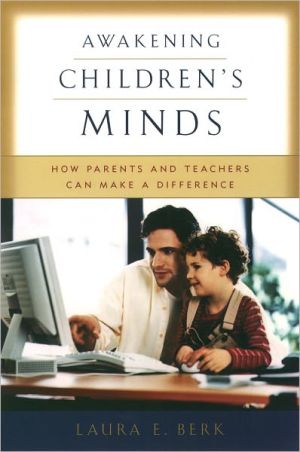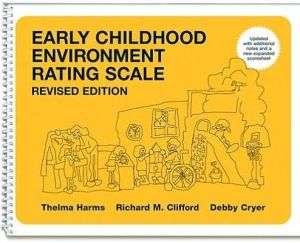Awakening Children's Minds: How Parents and Teachers Can Make a Difference
Parents and teachers today face a swirl of conflicting theories about child rearing and educational practice. Indeed, current guides are contradictory, oversimplified, and at odds with current scientific knowledge. Now, in Awakening Children's Minds, Laura Berk cuts through the confusion of competing theories, offering a new way of thinking about the roles of parents and teachers and how they can make a difference in children's lives.\ This is the first book to bring to a general audience,...
Search in google:
Parents and teachers today face a swirl of conflicting theories about child rearing and educational practice. Indeed, current guides are contradictory, oversimplified, and at odds with current scientific knowledge. Now, in Awakening Children's Minds, Laura Berk cuts through the confusion of competing theories, offering a new way of thinking about the roles of parents and teachers and how they can make a difference in children's lives. This is the first book to bring to a general audience, in lucid prose richly laced with examples, truly state-of-the-art thinking about child rearing and early education. Berk's central message is that parents and teachers contribute profoundly to the development of competent, caring, well-adjusted children. In particular, she argues that adult-child communication in shared activities is the wellspring of psychological development. These dialogues enhance language skills, reasoning ability, problem-solving strategies, the capacity to bring action under the control of thought, and the child's cultural and moral values. Berk explains how children weave the voices of more expert cultural members into dialogues with themselves. When puzzling, difficult, or stressful circumstances arise, children call on this private speech to guide and control their thinking and behavior. In addition to providing clear roles for parents and teachers, Berk also offers concrete suggestions for creating and evaluating quality educational environments—at home, in child care, in preschool, and in primary school—and addresses the unique challenges of helping children with special needs. Parents, Berk writes, need a consistent way of thinking about their role in children's lives, one that can guide them in making effective child-rearing decisions. Awakening Children's Minds gives us the basic guidance we need to raise caring, thoughtful, intelligent children.
Awakening Children's Minds\ How Parents and Teachers Can Make a Difference \ \ By Laura E. Berk \ Oxford University Press\ Copyright ©2004 Laura E. Berk\ All right reserved.\ ISBN: 0195171551 \ \ \ \ \ Chapter One\ \ \ A New View of Child Development\ \ \ In my three decades of teaching university courses in child development, I have come to know thousands of students, many of whom were parents or who became parents soon after completing my class. I also served on boards of directors and advisory committees for child-care centers, preschools, elementary schools, and parent organizations. And my research continually drew me into classrooms, where for countless hours I observed and recorded preschool and school-age children's activities, social interactions, and solitary behaviors, in hopes of answering central questions about how they learn.\ As a byproduct of those experiences, parents repeatedly approached me with concerns about how to foster their child's development in the early years. Their fervent questions, at times riddled with doubt and anxiety, revealed that creating optimum learning environments for young children at home—and ensuring their access to development-enhancing experiences in child care, preschool, and school—have become mounting parental challenges.\ Consider the following problematic situations thatparents recently raised with me:\ \ \ · Bob and Sharon, parents of a 4-year-old: Our daughter, Lydia, could recite her ABCs and count from 1 to 20 by age 2 1/2. When we looked for a preschool, many programs appeared to do little more than let children play, so we chose one with lots of emphasis on academics. To me, Lydia's preschool seems like great preparation for kindergarten and first grade, but each morning, Lydia hates to go. Why is Lydia, who's always been an upbeat, curious child, so unhappy?\ · Angela, mother of a 4-year-old and 6-year-old: My husband and I have demanding careers and need to bring work home in the evenings. I've read that it's the quality of time we spend with our children that's important, not the quantity. We try hard to give Victor and Jeannine our undivided attention, but they're often whiny, demanding, and quarrelsome. Many times we end up sending them to their rooms or letting them watch TV, just to get some peace after a long day. What's the best way to create quality parent-child time?\ · Talia, mother of a 7-year-old: My son Anselmo, a first grader, constantly asks us to help him with his homework. His father firmly insists that he do it by himself. Anselmo tries, but he gets so frustrated and upset that I move in and help, even in the face of opposition from his dad. By that time, Anselmo is on such a short string that I do most of the assignment for him. Should we be helping Anselmo with his homework and, if so, how?\ · Noah and Suzanne, parents of a 2-year-old: When our parents were raising us, they seemed confident of their power and influence. Recently we read that how children turn out is mostly written in their genes; there's little we as parents can do about it. Does parenting really matter?\ \ \ BAFFLED, BEWILDERED PARENTS\ \ \ Despite being well educated, intent on doing what's best for their children, and enlightened by a vast literature of child-rearing advice, many American parents appear uneasy and unsure of their roles at best, baffled and bewildered at worst. As the above sampling of concerns reveals, today's parents are not just worried about major transitions and traumas, such as the impact of marital breakup or community violence. They agonize over commonplace, recurrent, everyday situations—whether intensive preschool academic tutoring is crucial for later success in school, the meaning of "quality time" with children, and whether and how to help their child with homework. At an even more fundamental level, contemporary parents have begun to doubt their own efficacy in their children's development. Why is this so?\ The reasons, I believe, are twofold. First, rapid societal changes have complicated parents' task, making child rearing more challenging than in previous generations. Second, information about child development disseminated to parents is increasingly voluminous but at the same time contradictory. It fails to offer a clear, consistent vision of good child rearing to guide daily decision making and practice. Let's take a closer look at these sources of parental frustration and confusion.\ \ \ Societal Changes\ \ \ Over the past three decades, external forces impinging on the family have transformed parents' and, therefore, children's lives. Overall, parents complain that they have less free time to spend with their children. Witness a 1995 survey of a large, representative sample of American workers, nearly 25 percent of whom expressed the feeling that the demands of their jobs left them with "no time for family." Compounding their worries, employed parents must, out of necessity, turn over many hours of child rearing to other adults. Yet once their children are beyond their grasp, they are hardly off the hook! Conscientious parents face an added responsibility: monitoring their child's whereabouts and activities, verifying from a distance that their youngster is physically safe, emotionally contented, and constructively engaged.\ Although many societal conditions heighten parents' struggle to rear psychologically healthy children, two are especially pernicious, affecting even parents who manage to escape the trials and tribulations of divorce, single parenthood, stepchildren, serious financial worries, and other family stresses. The first is the dire shortage of acceptable child-care options in the United States, the second is the parental dilemma of "never enough time." In view of these difficulties, it is little wonder that so many American parents express a sense of powerlessness and inadequacy when it comes to affecting their children's development.\ \ \ THE PROBLEM OF CHILD CARE. In 1970, 30 percent of mothers with preschool children were in the labor force, a figure that increased more than twofold, to 62 percent, by 2000. An obvious solution to reconciling parents' employment needs with young children's rearing needs is to make high-quality, nonparental care, with characteristics known to promote healthy psychological development, widely available and affordable. In Australia and Western Europe, child care is nationally regulated and liberally funded to ensure that it conforms to standards verified by research to foster children's learning, social competence, and emotional security.\ Without a nationally regulated and generously subsidized child-care system, formal child care in the United States is in much shorter supply and considerably more costly for parents than it is in other industrialized nations. And as our discussion in Chapter 6 will reveal, on the whole, the quality of American child care—whether center-based or home-based—is mediocre to abysmal. Indeed, so widespread is poor-quality child care in the United States that Americans have acclimated to it. In a recent survey of parents whose children were enrolled in several hundred randomly chosen child-care centers across four states, over 90 percent believed that their preschoolers' experiences were far better than experts in early childhood development judged those experiences to be. Parents seemed unable to distinguish "good" from "substandard" care.\ \ \ THE "TIME BIND." Like many parents, Angela, who raised the question of quality time, complains of being "torn in many directions." Often she leaves work in a hurry in the late afternoon to pick up Victor and Jeannine from child care, dashes to Victor's tumbling class or Jeannine's piano lesson, then stops at the grocery store to pick up something for dinner. When Angela and her husband, Tom, walk through their front door, they typically head to the phone or fax machine to take care of unfinished work while trying to quell Victor and Jeannine's hunger and irritability with a frozen dinner popped into the microwave and unlimited access to the TV set. Caught in a ceaseless sprint to reconcile job, marriage, and parenting, Angela and Tom feel drained at the end of the day—too tired to grant their children more than 10 or 15 minutes of focused time. When Victor and Jeannine do get their parents' undivided attention, they are argumentative and unruly, compounding their parents' fatigue and impatience.\ Angela and Tom represent a growing number of American parents who try to pencil children into busy schedules, much like a business appointment. They love their children, but they also love and need their work, for personal and financial reasons. Hence they find themselves in a juggling act between the two, with work usually winning out. Tomorrow will be another day for the kids, they rationalize, but a business deal or a professional achievement, if not capitalized on at the moment, may evaporate. Their logic dovetails with the concept of "quality time" for children. In its commonly accepted meaning, quality time refers to an intense but brief contact. The term is a ready salve for the consciences of conflicted parents, who squeeze in a few moments with their children, catch-as-catch-can, yet sense deep down that they are robbing their youngsters—and themselves—of something vital.\ The expression "quality time" dates back to the 1970s, a decade that witnessed the largest rise in women's participation in the labor force during this century. The notion was bolstered by observational studies of parent—child interaction. In these investigations, some parents exchanged positive emotional signals with and verbally stimulated their infants, and read to and conversed with their preschoolers. Other parents spent time with their children but were not actively engaged with them. Time and time again, children of the first set of parents developed more favorably, cognitively and socially, than did children of the second set of parents.\ A close look at the research reveals that children who fared well experienced effective interaction over an extended period. In studies following children from infancy into childhood and adolescence, early brief episodes of parental stimulation and sensitivity did not result in more competent children. Instead, positive, supportive parenting that endured, even when it marked a change from an early period of parental retreat or negative interaction, was linked to favorable child development, including persistence in problem solving, high self-esteem, socially skilled behavior, closer friendships, and better peer relationships. In sum, high-quality involvement with children requires a certain quantity of time—actually, a great deal, as I'll argue in this book.\ In Angela and Tom's case, sandwiching concentrated time with Victor and Jeannine between work and other obligations, which often took precedence over family rituals, meant that routines that signal parental caring and that are major sources of development went by the wayside. For example, family dinnertimes and storybook reading at bedtime became rare events. So did the sheer enjoyment that comes from relaxed parent-child play; a joint cooking, art, or construction project; and a conversation based on real listening and exchange of ideas. Because these experiences were so few and short-lived, Angela and Tom were deprived of valuable opportunities to observe their children closely and to become intimately familiar with their talents, shortcomings, preferences, styles of learning, and ways of coping with hardship—knowledge that is crucial for helping children develop into mature, competent individuals.\ Furthermore, the "time bind" stifles an essential child-rearing responsibility that I mentioned earlier and will return to again: monitoring children's experiences while they are both within and beyond parents' immediate reach. This includes frequently touching base with nonparental caregivers and teachers to find out what's happening at child care or in the classroom; looking in on sibling and peer interaction to make sure that it is positive and respectful; and controlling time spent watching TV and playing video games.\ In a recent provocative study, sociologist Arlie Hochschild spent months getting to know employees at a large Midwestern corporation she called Americo. Whether clerical workers or executives, the majority confirmed the parental state of mind just described: They complained of overly long workdays and frenetic home lives. A surprising finding, however, was that few Americo workers had taken steps to make work and family more compatible. For example, even well-paid employees were not taking the annual six weeks of federally guaranteed, unpaid family leave time, although they could afford to do so. Nor were they asking for job share or flextime, prominent company policies aimed at increasing the compatibility of work and home. Hochschild concludes, "Many working families are both prisoners and architects of the time bind in which they find themselves."\ As homes become frenzied places in which work encroaches on family time and parents are too exhausted or preoccupied to be physically and psychologically available, children quickly become discipline problems. Their disagreeable behavior often causes parents to retreat further into the haven of work. On the job, such parents feel competent and gratified; home has turned into a place where they are harried, annoyed, and must deal with children who sulk, complain, plead for gifts, and are obstinate until they get their way—reactions that cry out, "Fifteen minutes, here or there, with an essentially distracted parent, is not enough."\ Fortunately, not all reports are as disturbing as Hochschild's. Psychologist Rosalind Barnett and journalist Caryl Rivers conducted extensive interviews with 300 dual-earner couples in the Boston area and found that despite stress at work and at home, most were highly satisfied and found child rearing to be both manageable and pleasurable. And in a survey of 6,000 employees at DuPont, nearly half—and only slightly more women than men—turned down upward career moves to remain in jobs that allowed for more family commitment. Barnett believes that parents most prone to a time bind in which work robs family life are at higher socioeconomic levels—in more pressured jobs that have less clearly defined limits and in which advancement typically depends on superlative performance. Ironically, she notes, economically less well off parents find it easier to establish a viable dividing line between workplace and home.\ Although the precise extent of family-work conflict in American culture is not clear, its presence and detrimental impact on parent-child interaction and children's development are well founded. Consider a series of studies that examined length of maternity leave in relation to employed mothers' psychological well-being and parenting behaviors. Short leaves of 6 weeks or less (the norm in the United States) were linked to maternal anxiety and depression and negative interactions with babies. But longer leaves, of 12 weeks or more, predicted favorable maternal mental health and sensitive, responsive parenting.\ Furthermore, long hours in child care during infancy and the preschool years are linked to less favorable parent-child interaction. One study included repeated observations of more than 1,200 mothers, of diverse socioeconomic and ethnic backgrounds, playing with their children between 6 months and 3 years of age. The more time children spent in child care (which ranged from o to 50 hours per week), the less positive and responsive their mothers' behavior tended to be. Children experiencing less positive interaction were less engaged with their mothers—more negative in mood and less affectionate. Yet another study—this time, of 3- to 5-year-old firstborn sons—suggested that long child-care hours can translate into behavior problems. Mothers and fathers of boys with many hours in child care interacted less favorably with their sons. And such parents reported more noncompliant, defiant child behavior.\ These findings are not an indictment of maternal employment or nonparental child care. Rather, they underscore the importance of considering the needs of children when making work and child-care decisions. Studies carried out during the 1970s and 1980s on the relationship of maternal employment to children's development revealed many positive outcomes—higher self-esteem, better grades in school, more positive family and peer relations, and less gender-stereotyped beliefs. But repeatedly, effective parenting mediated these favorable developments.\ Employed mothers of cognitively competent, well-adjusted children value their parenting role and succeed at coordinating it with job responsibilities. Such mothers schedule regular times to devote to their children and combine warmth with consistent expectations for mature behavior. Consider a study of the relationship of maternal employment to first graders' academic and social competence. Children of working mothers were equally or more competent than children of homemakers only if the children frequently experienced mother-child shared activities, such as warm conversation and play. Shared activities were especially crucial for children of mothers who had increased their hours of employment during the preceding 3 years, often from part-time to full-time. When a change in employment status was associated with high mother-child engagement, children fared well. When it led to reduced mother-child engagement, children's competence suffered greatly.\ Fathers' involvement in child rearing is an additional route to positive outcomes for children. Although women devote more than three times as many hours to child care as men do, fathers' involvement has risen in recent years. Children of highly involved fathers score better on measures of intelligence, school achievement, mature social behavior, and flexible beliefs about gender roles—in short, on all the positive outcomes associated with maternal employment. When mothers and fathers support each other and share child-rearing responsibilities, both engage in more effective parenting.\ In sum, increasingly pressured adult lives have contributed to parental difficulties in granting children the attention they need. When employed parents spend generous amounts of time engaged with their child, they safeguard the child's development. Under these conditions, children often reap extra benefits from more equitable involvement of both parents. In contrast, a pressured work life that pulls parents away from child rearing undermines infants' and children's well-being—cognitively, emotionally, and socially.\ Probably because it reduces work overload, part-time maternal employment is associated with better academic and social development than is full-time employment. Unfortunately, most American employers do not provide this option, and many parents—especially, single parents—cannot afford it. Yet as noted earlier, financially well-off parents are especially prone to the "time bind" but do not necessarily take advantage of available workplace options aimed at lessening it.\ \ \ Child-Rearing Advice\ \ \ Almost all parents—especially first-time parents—feel a need for sound advice on how to rear their children. The demand for expert advice is particularly great today, perhaps because parents, teachers, and the general public perceive that children's problematic behavior has increased. Widespread parent and teacher opinion, gathered from nearly 700 respondents in 1976 and again in 1989, revealed that during this 13-year period, children were viewed as more likely to "do poorly on schoolwork," "hang around with peers who get into trouble," and "destroy things belonging to others." Fewer were seen as involved in worthwhile activities that truly engaged them. A 1997 survey of 4,500 American adults, 2,500 of whom were parents, echoed this disheartening trend. Most viewed today's youngsters as too out-of-control and undirected.\ The call for parenting advice has led to a proliferation of volumes, filling shelf after shelf in virtually every general-purpose bookstore and public library. The "correct methods" advocated in these books vary widely, with many addressing discipline and communication, thereby catering to rising numbers of parents with undercontrolled, apathetic, non-goal-directed children. Precious few of these parenting manuals are grounded in the explosion of contemporary research on child development that is of significant applied value. Rather, a plethora of opinion is available, some of it playing on and exacerbating parents' self-doubts with such titles as Parenting for Dummies and The Seven Worst Things Parents Do.\ \ \ ONE-SIDED VIEWS. Well-known theories of child development—Freud's, Skinner's, Gesell's, and Piaget's, for example—provide little comfort, since dramatic shifts in favored theories have occurred since the launching of systematic study of children about 100 years ago. Indeed, this waxing and waning of theories has contributed greatly to discrepancies in expert child-rearing advice, which (like the theories) has fluctuated between extremes—swinging, like a rhythmic pendulum, from an adult-imposed, directive approach to a child-centered, laissez-faire approach, and back again. As one recent analyst commented, theories and the popular literature for parents "have done their share to undermine the wavering self-confidence of American parents." The roots of these polarized perspectives can be found in centuries-old, dramatically opposing philosophies about the nature of children and child development.\ Adult Supremacy. Writing at the end of the seventeenth century, British philosopher John Locke characterized the child as a tabula rasa. Translated from Latin, this means "blank slate" or "empty container," a being who can be freely "written on," or "filled," with socially acceptable knowledge and skills—in essence, molded in any way adults might desire through careful instruction, effective example, and rewards for good behavior. Lockean ideas provided the footing for American behaviorism, launched by John Watson in the early 1900s and built by B. F. Skinner into a powerful mid-century theoretical force heralding the supremacy of environment in its belief that behavior is shaped by external stimuli.\ \ \ Continues... \ \ \ Excerpted from Awakening Children's Minds by Laura E. Berk Copyright ©2004 by Laura E. Berk. Excerpted by permission.\ All rights reserved. No part of this excerpt may be reproduced or reprinted without permission in writing from the publisher.\ Excerpts are provided by Dial-A-Book Inc. solely for the personal use of visitors to this web site. \ \
PrefaceAcknowledgments1A new view of child development32The social origins of mental life373Why children talk to themselves754Learning through make-believe play1075Helping children with deficits and disabilities1466Learning in classrooms1817The child in contemporary culture220Conclusion : a vision for parenting and educational practice245Notes251Index297
\ From the Publisher"Berk minces no words in this important book on a much-debated subject.... Her lucid insights are complemented by examples throughout the text. Berk's application of sociocultural theory makes this an essential title in the child development collections of academic and public libraries, and her suggestions about how to structure home and school environments make this an invaluable reference for school administrators and daycare operators as well."--Library Journal (starred review)\ "Berk illustrates her concepts with observed dialogues and cites many studies and examples. Instructive and even inspiring...educators and motivated parents will find much to explore."--Publishers Weekly\ "This is one incredible book! A veritable college course for parents on children's mental development, richly detailed, persuasively reasoned, and sensitively conveyed. Its contents are directly linked to the explosive growth in scientific knowledge in developmental psychology yet rendered in a style not at all stuffy or pompous. Among the best advice the science of child psychology has to offer, this book contains not a shred of nonsense, folklore, or unscientific advice.... Exceptionally informative, this books strikes just the right balance among the various influences that determine a child's mental development. It does so without talking down to parents, treating them instead as the experts they are on their children yet who are in search of further information on what science has to tell us about our children's development."--Russell A. Barkley, Professor of Psychiatry and Neurology, University of Massachusetts Medical School\ "In this wonderful volume Berk outlines some of today's most exciting ideas about child development. She goes well beyond theory, however, by providing insightful suggestions for concrete practice. This is a powerful, yet accessible text by a major author that promises to have a major impact for years to come on how we go about teaching and parenting."--James V. Wertsch, Professor and Chair, Department of Education, Professor, Department of Psychology, Washington University in St. Louis\ "A refreshingly practical and pragmatic guidebook for parents and teachers of young children. Complex and controversial concepts, such as biological vs. environmental influences, are readily understandable through the use of vignettes, illustrations, and clear explanations. Berk emphasizes the critical role of adults as she offers insights into young children's thoughts, emotions, and actions and discusses accompanying implications for practice."--Kathy R. Thornburg, Director of the Center for Family Policy and Research, University of Missouri\ \ \








